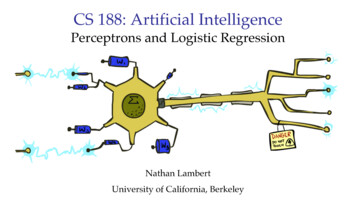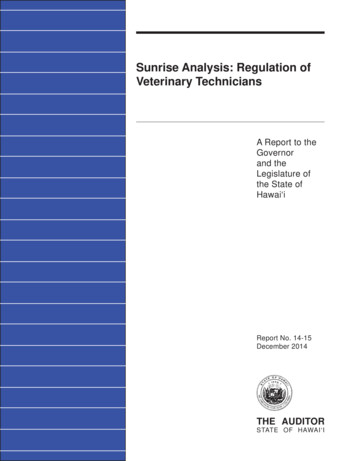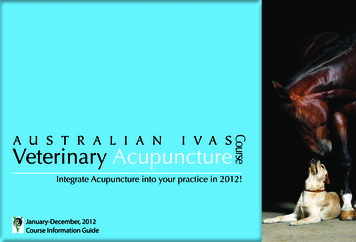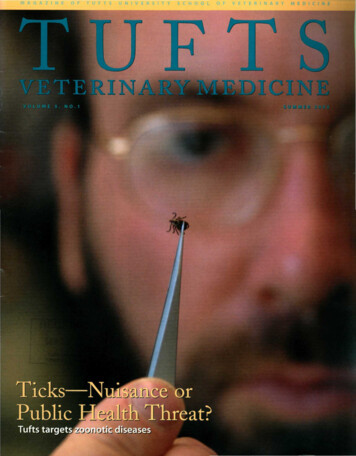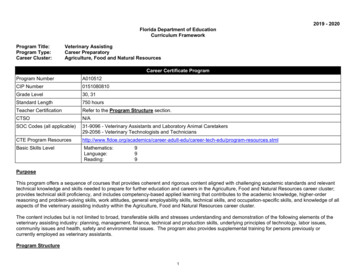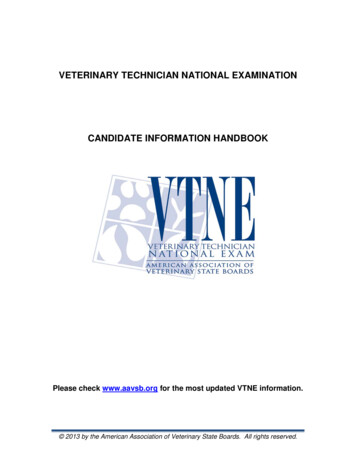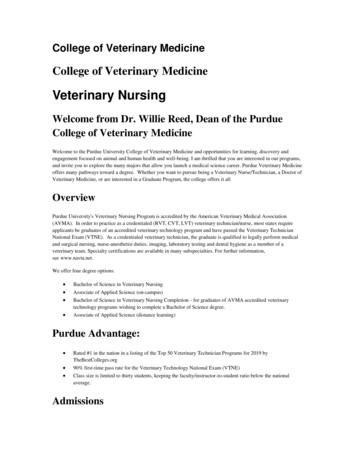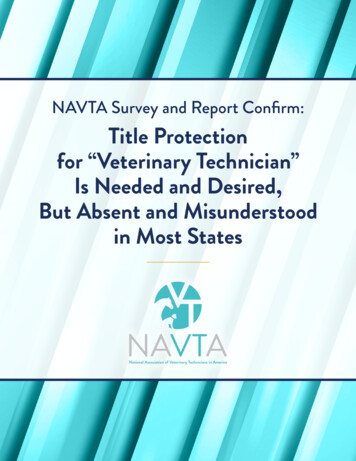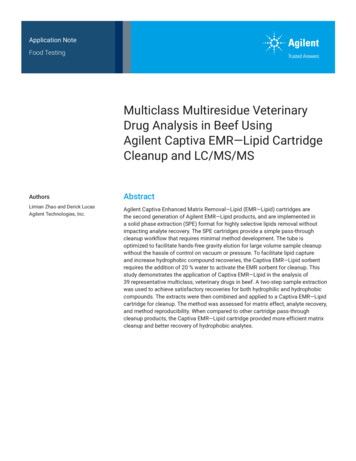
Transcription
Application NoteFood TestingMulticlass Multiresidue VeterinaryDrug Analysis in Beef UsingAgilent Captiva EMR—Lipid CartridgeCleanup and LC/MS/MSAuthorsAbstractLimian Zhao and Derick LucasAgilent Technologies, Inc.Agilent Captiva Enhanced Matrix Removal—Lipid (EMR—Lipid) cartridges arethe second generation of Agilent EMR—Lipid products, and are implemented ina solid phase extraction (SPE) format for highly selective lipids removal withoutimpacting analyte recovery. The SPE cartridges provide a simple pass-throughcleanup workflow that requires minimal method development. The tube isoptimized to facilitate hands-free gravity elution for large volume sample cleanupwithout the hassle of control on vacuum or pressure. To facilitate lipid captureand increase hydrophobic compound recoveries, the Captiva EMR—Lipid sorbentrequires the addition of 20 % water to activate the EMR sorbent for cleanup. Thisstudy demonstrates the application of Captiva EMR—Lipid in the analysis of39 representative multiclass, veterinary drugs in beef. A two-step sample extractionwas used to achieve satisfactory recoveries for both hydrophilic and hydrophobiccompounds. The extracts were then combined and applied to a Captiva EMR—Lipidcartridge for cleanup. The method was assessed for matrix effect, analyte recovery,and method reproducibility. When compared to other cartridge pass‑throughcleanup products, the Captiva EMR—Lipid cartridge provided more efficient matrixcleanup and better recovery of hydrophobic analytes.
IntroductionVeterinary drugs are widely used in animal food to preventanimal diseases, or as a growth promoter. These drugscan accumulate in animal tissues, and improper use canresult in drug residues in edible tissues, resulting in risksto human health. With increased public attention on foodsafety, regulation of veterinary drugs used in animal foodproduction is imposed in most countries1,2. Animal foods,such as muscle, liver, and eggs, are complex matrices; thus itis critical to use an efficient preparation method for sampleextraction, cleanup, and concentration (when needed) beforeinstrumental analysis. The established sample pretreatmentmethods include traditional solvent extraction, solid phaseextraction (SPE), or a combination of techniques. Thesemethods are usually labor-intensive, time-consuming, andonly suitable for limited classes of compounds, requiringmethod development.Multiclass, multiresidue methods are increasingly becomingpopular in regulatory monitoring programs due to theirincreased analytical scope and laboratory efficiency. Analysisof more than 100 veterinary drugs has been reported inliterature in the past few years3-5. The sample pretreatmentusually involves pre-extraction with a mixture of acetonitrile(ACN)/water, followed by C18 cleanup or a combinationof other cleanup techniques. However, current cleanuptechniques have limitations such as inefficient lipid removaland unwanted analyte loss. The ACN/water mixture directextraction can compromise the protein removal efficiency andhydrophobic analyte extractabilities during the extraction step.Agilent Enhanced Matrix Removal—Lipid (EMR—Lipid) dSPEcleanup has gained a lot of attention since it was introducedin 2015. The EMR—Lipid sorbent specifically interacts withthe unbranched hydrocarbon chains of lipid compounds usinga combined mechanism of size exclusion and hydrophobicinteraction. This combined mechanism provides highlyselective lipid removal without unwanted impact on targetanalytes. This technology has been used for multiclass,multiresidue pesticides analysis in complex matrices,providing superior matrix cleanup and optimum results6,7.The second-generation product, Agilent Captiva EMR—Lipidcartridges, reduces the water percentage needed for sorbentactivation, and eliminates the need for a polishing stepsubsequently. This simplifies the workflow and improves thesolubility of hydrophobic compounds during cleanup.2This study investigates the use of Captiva EMR—Lipidcartridge cleanup during sample preparation for the analysisof 39 representative and challenging veterinary drugs inbeef. The selected representative veterinary drugs were from17 different classes including hydrophilic and hydrophobicdrugs, acidic, neutral, and basic drugs, and some of the mostdifficult classes, such as tetracycline and β-lactam. Table 1shows the drug class, regulatory information, retention time,and MS/MS conditions for analysis of these veterinary drugs.ExperimentalReagent and ChemicalsAll reagents and solvents were HPLC or analytical grade.Acetonitrile (ACN) was from Honeywell (Muskegon, MI, USA).Dimethyl sulfoxide (DMSO) and ethylenediaminetetraaceticacid, disodium salt, dehydrate (NaEDTA) were fromSigma‑Aldrich (St Louis, MO, USA). Reagent grade formicacid (FA) was from Agilent (p/n G2453-86060). The veterinarydrugs standards and internal standard were purchased fromSigma‑Aldrich (St Louis, MO, USA).Solution and StandardsStandard and internal standard (IS) stock solutions weremade in DMSO at 2.0 mg/mL, except for the following: Danofloxacin stock solution was made in DMSO at1.0 mg/mL. Ciprofloxacin stock solution was made in DMSO at0.25 mg/mL.All the β-lactam drugs and cefazolin stock solutions weremade in water at 2.0 mg/mL. All stock solutions wereprepared in amber glass vials, except for β-lactam drugs,Cefazolin, and tetracycline drugs stock solutions, whichwere prepared in polypropylene plastic tubes. All solutionswere stored at –20 C. The 39 compounds were separatedinto two groups: group 1 (G1) and group 2 (G2), based ontheir instrument response. Two combined standard workingsolutions, 25/5 µg/mL and 5/1 µg/mL (G1/G2), were preparedin 1:1 ACN/water. A 25 µg/mL working solution of Flunixin-d3IS was prepared in 1:1 ACN/water.A cold extraction solvent was prepared daily by adding 2 mLof formic acid and 2 mL of DMSO into 100 mL of precooledACN. A 0.1 M Na EDTA solution was made by dissolving1.8612 g of NaEDTA powder in 50 mL Milli-Q water. Thesolution was stored at room temperature. A 80:20 ACN/waterwas made by combining 80 mL of ACN with 20 mL of Milli-Qwater.
Table 1. List of selected veterinary drugs for analysis; drug class, US tolerance, retention time, and MRM conditions.Drug classPolarityPrecursor ion(m/z)Quant ionCE (v)Qual lyteMetronidazole-OHRetention time(min)Product ionUS tol.(µg/g)CE Penicillin tazoneNSAID–7.47NEG323.129517133.925Flunixin-d3 2526441Flunixin-d3 (POS)Melengestrol Flukicide–9.07NEG352.916121191.825Tolerance in uncooked edible tissue of cattleTolerance in cattle livercTolerance in swine muscledBanned for extralabel useeTolerance is for the sum of residue of tetracycline including chlortetracycline, oxtetracycline, tetracycline in musclefTolerance in cattle musclegTolerance in uncooked cattle fat, muscle, liver, and kidneyhTolerance in cattle fatab3
Equipment and MaterialHPLC conditionsSeparation was carried out using an Agilent 1290 InfinityUHPLC system consisting of an:ParameterValueAgilent InfinityLab Poroshell 120 EC-C18,150 2.1 mm, 2.7 µm (p/n 693775-902)Agilent InfinityLab Poroshell 120 EC-C18 UHPLCguard, 5 2.1 mm, 2.7 µm (p/n 821725-911) Agilent 1290 Infinity binary pump (G4220A)Column Agilent 1290 Infinity high performance autosampler(G4226A)Flow rate0.3 mL/minColumn temperature40 CAutosampler temperature4 CInjection volume3 µLThe UHPLC system was coupled to an Agilent G6490 TripleQuadrupole LC/MS system equipped with an Agilent JetStream electrospray ionization source. Agilent MassHunterworkstation software was used for data acquisition andanalysis.Mobile phaseA) 0.1 % FA in waterB) 0.1 % FA in acetonitrileNeedle wash1:1:1:1 ACN/MeOH/IPA/H2O w/ 0.2 % FAGradientTime (min)00.58.0Other equipment used for sample preparation:Stop time12 minutes 2010 Geno/Grinder (Metuchen, NJ, USA)Post time3 minutes Centra CL3R centrifuge (Thermo IEC, MA, USA) Multi Reax Test Tube Shaker (Heidolph, Schwabach,Germany) Agilent 1290 Infinity thermostatted column compartment(G1316C) Eppendorf pipettes and repeater Agilent Captiva EMR—Lipid cartridge, 6 mL, 600 mg(p/n 5190-1004) and, 3 mL, 300 mg (p/n 5190-1003) Agilent Vac Elut SPS 24 Manifold with collection rack for16 100 mm test tubes (p/n 12234004)Parameter After prespiking the standard and IS into thehomogenized beef sample, the samples stood at roomtemperature for 20 minutes. This allowed the spikedstandards to infiltrate the sample matrix and equilibrateprior to sample extraction. The use of water for sample extraction is necessary toachieve homogeneous mixing with the beef, and ensurethe recovery and stability of the polar drug compounds.4Gas temperature120 CGas flow14 L/minNebulizer40 psiSheath gas heater400 CSheath gas flow12 L/minCapillary3,000 viFunnel parametersPositiveHigh-pressure RF 90 VLow-pressure RF 70 VNegative90 V60 VA one-step extraction with a 20:80 water/ACN mixturegreatly reduces the solvent extractability of hydrophobiccompounds and protein removal efficiency. Therefore, atwo-step extraction protocol was used: a 2 mL aqueousextraction followed by an 8 mL solvent extraction.Sample PreparationBeef purchased from a local grocery store was used formethod development and the validation study. Sampleswere homogenized and stored at –20 C.ValuePositive/negative modeFigure 1 shows the typical chromatograms for A) beef extractmatrix blank, and B) beef extract fortified with 5/1 ng/g(G1/G2) veterinary drug standards (limit of quantitation level). Flow rate (mL/min)0.30.30.3MS conditionsInstrument ConditionsFigure 2 shows the final sample preparation procedureto prepare beef samples. The following points need to beemphasized for the optimized extraction and cleanup methodfor the beef samples:%B1010100 To prevent loss of tetracycline compounds due tochelation, a 0.1 M EDTA buffer solution was used foraqueous extraction. To improve solvent extractability for difficult drugcompounds, such as tetracycline, β-lactam, andfluoroquinolones, 2 % formic acid and 2 % DMSO wasadded into the extraction solvent, ACN. To improve the phase separation with solid residues,especially in the first aqueous extraction step, a cooledcentrifugation (4 C) was used. To ensure the complete elution of analytes from thecartridge, a secondary elution after EMR—Lipid cartridgecleanup was performed.
1033.6A3.2Counts2.82.42.01.61.20.80.400.5 1033.61.01.52.02.53.03.54.04.5 5.0 5.5 6.0 6.5Acquisition time 5 5.0 5.5 6.0 6.5Acquisition time .20.80.400.5Figure 1. LC/MS/MS chromatograms for A) beef extract matrix blank, and B) beef extract fortified with 5/1 ng/g (G1/G2) vet drugstandards. Group 1 (G1) analytes correspond to a 5 ng/g fortification level, while group 2 (G2) compounds correspond to a 1 ng/gfortification level. Refer to Table 1 for analyte identification with elution order, and Table 2 for compound group identification.Accurately weigh 2 g of comminuted meat sample into a 50-mL centrifuge tube.Add 2 mL of 0.1 M EDTA solution to Tube 1.Cap and shake vigorously for 2 minutes.Centrifuge at 5,000 rpm at 4 C for 5 minutes.Add 8 mL of ACN with 2 % formic acid and2 % DMSO to the sample residue left in Tube 1.Shake 5 minutes, then centrifuge at 5,000 rpm at 4 C for 5 minutes.Transfersupernatant toTube 2Decant supernatant to Tube 2Vortex the combined extract in Tube 2 for 2 minutes,then centrifuge at 5,000 rpm at 4 C for 5 minutes.Transfer 5 mL of supernatant to an Agilent Captiva EMR—Lipid 6 mL cartridge,and allow elution by gravity.Add 1.25 mL of 80:20 ACN/water into the EMR—Lipid cartridgefor secondary elution.Gradually apply vacuum to drain the cartridge when thereis no visible liquid left in cartridge.Combine 0.5 mL of sample eluent and 0.3 mL of water in the sample vial,and vortex.Samples are now ready for LC/MS/MS analysis.Figure 2. Beef sample extraction and following cleanup procedure using an Agilent Captiva EMR—Lipid 6 mL cartridge.5
Calibration Standards and Quality Control (QC) SamplesAnalyte Recovery Assessment by Cartridge CleanupPrespiked QC samples were fortified by spiking appropriatestandard working solution into the homogenized beefsamples with six replicates of low, mid, and high levels.Cartridge cleanup impact on analyte recovery was evaluatedby prespiking standards into beef extract blank beforecartridge cleanup, and postspiking standards into beef extractblank eluent after cartridge cleanup. The collected recoveryresults only reflect the impact of cartridge cleanup on analyterecovery, and exclude other contributions from the extractionprocedure. It is a more direct comparison of cartridge cleanupimpact on analyte recovery. The EMR—Lipid cartridges,3 mL and 6 mL, were compared to corresponding othermanufacturer’s cartridges. For 3 mL cartridges, the sampleloading volume was 2.5 mL, and the secondary elutionvolume was 0.625 mL. For G1 analytes, the spiking levels were 10, 50, and750 ng/g. For G2 analytes, the spiking levels were 2, 10, and150 ng/g.A standard 25/5 µg/mL (G1/G2) working solution was usedto spike high-level QC samples; while a 5/1 µg/mL (G1/G2)standard solution of was used to spike low and mid QCsamples. The IS solution was also spiked into all samplesexcept matrix blank, corresponding to 200 ng/g of Flunixin-d3.Matrix-matched calibration standards and postspiked QCsamples were prepared by spiking appropriate standardand IS working solutions into the matrix blank eluent aftercartridge cleanup. The spiking concentrations for calibrationstandards were 5, 25, 50, 250, 750, and 1,000 ng/g (G1) or1, 5, 10, 50, 150, and 200 ng/g in beef (G2), and 200 ng/g IS;spiking concentrations for postspiked QC samples were 10,50, and 750 ng/g (G1) or 2, 10, and 150 ng/g (G2).Determine the Amount of Co-extractivesThe amount of co-extractive residue was determined bygravimetric measurements5 for EMR—Lipid cartridge andother manufacturer’s cartridge cleanup. The co-extractiveresidue weight was collected based on 1 mL of ACN finalextract, while the matrix co-extractives removal efficiencyby cleanup was calculated by comparing the ratio of thedifference of co-extractive residue weight with and withoutcartridge cleanup.Matrix Effect AssessmentChromatographic matrix effect was assessed by a postcolumn infusion test. The matrix blank samples were injectedwith simultaneous post column infusion of a 10 ng/mL neatstandard veterinary drug solution at 90 µL/min. All compoundtransitions were monitored through the chromatographicwindow.6Method ValidationTo ensure calibration reproducibility, the developed methodwas validated by running a full quantitation batch with twoseparate calibration curves run before and after the QCsamples.Results and DiscussionEase of Cartridge CleanupAn important feature of using Captiva EMR—Lipid cartridgesfor complex sample matrix cleanup is ease-of-use. TheEMR—Lipid sorbent targets unwanted lipid interferencesinstead of analytes, and implements a pass‑throughapproach. The sample mixture is loaded onto the cartridgeand is allowed to pass through the packed Captiva EMR—Lipidsorbent in the cartridge. Lipids are trapped in the sorbent,while target analytes pass through the cartridge, foregoing theneed for traditional SPE steps such as conditioning, washing,and elution. Therefore, the use of Captiva EMR—Lipidcartridges is greatly simplified, saving a significant amountof time and solvent. The pass‑through cleanup does not needtraditional SPE method development for washing and elutionsteps. A possible method modification for Captiva EMR—Lipidis the use of a secondary elution step to achieve completeelution. It is recommended to use a 20:80 water/ACN mixtureat approximately 20–25 % of the sample loading volume forsecondary elution (for example, a 5 mL load followed by a1–1.25 mL second elution). Lastly, the product design forgravity elution allows hands-free operation once the sampleis loaded onto EMR—Lipid cartridges. Control of the elutionflow rate by manipulating vacuum or positive pressure is notrequired. These features provide increased lab productivitywhen using Captiva EMR—Lipid cartridge cleanup to preparecomplex food samples.
Amount of Co-extractivesThe less matrix co-extractive residue, the better methodreliability and instrument performance. The results clearlydemonstrated that Captiva EMR—Lipid cartridge cleanupprovided better matrix cleanup efficiency with lessco‑extractive residue weight than the other manufacturer’scartridge cleanup.Table 2 shows the sample co-extractives gravimetrictest results. The co-extractive residue weight study is animportant method to evaluate how efficient sample extractionand cleanup method can control the residue of matrixco‑extractives, including proteins, lipids, salts, and othermatrix components in the final sample being injected onto theinstrument. Matrix co-extractives residue weight shows theentire co-extractives amount, whether they are detectable onan instrument or not. Co-extractive residues, whether beingdetectable on an instrument or not, can introduce matrixeffects, impact method reliability and data quality, accumulateon the instrument flow path, such as the column and MSsource, and deteriorate the detection system's long-termperformance.Matrix Effect AssessmentPostcolumn infusion (PCI) of veterinary drug standardswas used to evaluate matrix effects in beef extract with andwithout Captiva EMR—Lipid cartridge cleanup. All analyteswere monitored through the entire acquiring window. ThePCI profiles reflect the matrix impact for analytes monitoredunder both positive and negative mode. Figure 3 shows thePCI profiles.Table 2. Beef matrix co-extractives residue amount and matrix removal by cartridge cleanup.Cleanup techniqueCo-extractives per 1 mL of ACNfinal extract (mg)No further cleanup7.68–Agilent Captiva EMR—Lipid 3 mL cartridge4.3843Agilent Captiva EMR—Lipid 6 mL cartridge4.0348Other manufacturer's 3 mL cartridge5.9123Other manufacturer's 6 mL cartridge6.3018CountsMatrix co-extractives removal efficiency (%) CountsMatrix co-extractives removalefficiency by cleanup (%)(Amount of co-extractives without cleanup – Amount of co-extractives with cleanup)Amount of co-extractives without cleanup 100 1052.0 A1.8 Standard PCI profile with injection of beef matrix blank with Agilent Captiva EMR—Lipid cartridge cleanup1.61.41.21.00.80.60.40.20 1052.0 BStandard PCI profile with injection of beef matrix blank without cleanup1.81.61.41.21.00.80.60.40.200.5 1.0 1.5 2.0 2.5 3.0 3.5 4.0 4.5 5.0 5.5 6.0 6.5 7.0Acquisition time (min)7.58.08.59.09.5 10.0 10.5 11.0 11.5Figure 3. Matrix effect study by standard PCI with the injection of beef matrix blank with Agilent Captiva EMR—Lipid cartridgecleanup (A) and without any cleanup (B).7
Figure 3B shows the PCI profile in red, matrix ionsuppressions (overall low baseline) observed with theinjection of beef extract without cleanup. Matrix ionsuppression can dramatically impact the method sensitivity,reliability, and data quality for analytes within the coelutionwindow. Conversely, Figure 3A shows that the PCI profile(in blue) becomes much smoother and more consistent withfewer troughs when injecting beef extract with EMR—Lipidcartridge cleanup. The highlighted RT window in Figure 3shows the reduced matrix ion suppression effect comparison.Cartridge Cleanup RecoveryTraditionally, the mechanism for lipid removal is basedon hydrophobic interaction between lipids and sorbent.This mechanism can be efficient, especially when usingstrong hydrophobic interaction as the major sorbentfunction mechanism to trap and remove lipids. However,this interaction mechanism is not selective, and it doesnot differentiate unwanted lipids and wanted hydrophobicanalytes from sample. Therefore, while the sorbent works ontrapping lipids, it can also strongly interact with hydrophobicanalytes, resulting in dramatic analyte loss during thecartridge cleanup. Furthermore, not all classes of lipids canbe removed efficiently through hydrophobic interactions (forexample, phospholipids).Captiva EMR—Lipid sorbent uses a novel chemistry thatcombines size exclusion and hydrophobic interactionsto significantly improve lipid removal selectivity. Onlythe lipid‑like molecules containing straight unbranchedhydrocarbon chains, preferably with more than six carbons,have access to EMR—Lipid sorbent pores. Once the lipidsenter the EMR—Lipid sorbent, they are trapped inside withstrong hydrophobic interaction. Other hydrophobic moleculesthat do not resemble lipids and are too bulky to enter theEMR—Lipid sorbent will stay in solution for subsequentanalysis. Thus, EMR—Lipid sorbent can efficiently differentiatelipids from other hydrophobic molecules, dramaticallyimproving selectivity, and decreasing hydrophobic compoundloss during cleanup.This mechanism has been well proven by the cartridgecleanup recovery study. In this study, the standards wereprespiked into the beef blank extract before cartridge cleanup,and postspiked into the blank eluent after cartridge cleanup.The recovery data only indicate the cartridge cleanup impacton analytes. The comparison study included four types ofcartridges: Captiva EMR—Lipid 3 mL (300 mg) and 6 mL8(600 mg) cartridges, and other manufacturer’s 3 mL (60 mg)and 6 mL (500 mg) cartridges. Figure 4 shows the studyresults. The analytes shown in the comparison are morehydrophobic compounds, eluting later on the C18 column.EMR—Lipid 3 mL and 6 mL cartridges provide consistentsuperior cartridge cleanup recoveries for compoundsfrom mid to high hydrophobicity. However, for the othermanufacturer’s cartridge cleanup, which uses hydrophobicinteraction mostly for lipids removal, the more hydrophobic(late eluting) analytes had lower recovery. When thecomparable sorbent bed mass contained in 6 mL cartridges(500 mg) was used, the medium to high hydrophobiccompounds were significantly retained. For example, asthe last two most hydrophobic compounds, niclosamideand bithionol with log P 5, the other manufacturer's 6 mLcartridge cleanup recoveries were single digits, indicatingsubstantial analyte loss on-cartridge. Their 3 mL cartridgesuse much less sorbent to balance hydrophobic analyte loss.In summary, the other cartridge cleanup tube with 60 mgsorbent sacrifices the cartridge matrix cleanup efficiency,and increasing to a higher bed mass lowers the recoveries forhydrophobic compounds to unacceptably low levels ( 40 %).This study clearly demonstrates that EMR—Lipid sorbentprovides a highly selective interaction mechanism for lipids,ensuring acceptable target analyte recoveries, especially forhydrophobic analytes.Method ValidationThe optimized extraction and cleanup method was validatedby running a full quantitation batch. The methodology isdescribed in the Experimental section. Internal standard(Flunixin-d3 for both positive and negative mode) wasused for quantitation. However, as the absolute recoveriesare the greatest concern when evaluating a new samplepreparation method, the prespiked and postspiked QCs atthree levels were included in the validation run. Table 3 liststhe quantitation results in detail, and a summarized figure(Figure 5) was generated by average recovery and precisionat each level. Acceptable recoveries (60–120 %) wereachieved for most analytes at three levels (94 %), with theexception of two outliers, acepromazine and chlorpromazine.A confirmatory study reveals that these compounds canundergo analyte loss during the extraction step of theprotocol. However, the RSD values for six replicates of thesetwo compounds at each level were exceptional, with 10 %RSD for 91 % of analytes, and 10–20 % RSD for the remaining9 % of analytes.
Agilent Captiva EMR—Lipid 3 mLAgilent Captiva EMR—Lipid 6 mLOther manufacturer's 3 mL cartridgeOther manufacturer's 6 mL cartridge120100806040Significantly lowerrecoveries 10 lorproma.PenicillinV0epromAnalyte absolute recovery % for beef extractspiked with 10 ppb of vet drug standardsA45B40RSD% (n gure 4. Cartridge cleanup comparison for hydrophobic analyte recovery (A) and reproducibility (B) from beef extract. The standard was spiked into beef extractbefore cartridge cleanup at 10 ng/mL. Analytes order from left to right with increasing hydrophobicity.9
Table 3. Method quantitation results for veterinary drug analysis in beef.Calibration curveAnalyteR2Cal. idazole–OH1Group no.a2 ng/g QCs (n 6)10 ng/g QCs (n 6)50 ng/g QCs (n 6)150 ng/g QCs (n 6)750 ng/g QCs (n 1Penicillin 1983.0––862.81Melengestrol 0.2858.5––892.1––1aMethod absolute recovery and precisionGroup 1 analytes have calibration range of 5–1,000 ng/g, QC spiking level of 10, 50, and 750 ng/g; while group 2 analytes have calibration range of 1–200 ng/g, QC spikinglevel of 2, 10, and 150 ng/g.10
Absolute analyte recovery % (n 6 at each level)140Low QCMid QCBeefREC% 60 or 120REC% 60–80High QC120REC% 100–120REC% 80–1001008060RSD% 10–20Beef4020RSD% 100Figure 5. Absolute analyte recoveries and statistical summary of the analysis of veterinary drugs in beef method validation. Refer to Table 3 for more detailedinformation.ConclusionsA rapid, reliable, and robust method using solid-liquidextraction followed by Agilent Captiva EMR—Lipid cartridgecleanup was developed and validated for the analysis ofveterinary drug multiresidues in beef. A modified extractionprocedure applied an aqueous extraction step, followed by anorganic solvent extraction step to optimize analyte recovery.These extracts were combined and applied to the CaptivaEMR—Lipid cartridge for cleanup. Matrix co-extractives andmatrix effect was carefully assessed and compared withsimilar cartridges from another manufacturer. A study ofthe impact of cartridge cleanup on analyte recovery showsthat the EMR—Lipid sorbent provides highly selective lipidsremoval, and does not cause unwanted target analytes loss.Results demonstrate that optimized solid-liquid extractionfollowed by the Captiva EMR—Lipid cartridge cleanup methodprovides superior matrix cleanup, excellent recovery, andprecision results for this type of application.11
Agilent 1290 Infinity thermostatted column compartment (G1316C) The UHPLC system was coupled to an Agilent G6490 Triple Quadrupole LC/MS system equipped with an Agilent Jet Stream electrospray ionization source. Agilent MassHunter workstation software was used for data acquisition and analysis. Other equipment used for sample preparation:

